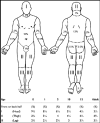Treatment algorithm in 960 pediatric burn cases: A review of etiology and epidemiology
- PMID: 30344573
- PMCID: PMC6191793
- DOI: 10.12669/pjms.345.15101
Treatment algorithm in 960 pediatric burn cases: A review of etiology and epidemiology
Abstract
Objective: Burn injuries are one of the most significant threats to life in both undeveloped and developing countries. In this study, we evaluate the demographic characteristics and treatment methods in pediatric burn cases admitted to our clinic.
Methods: A total of 960 patients aged 0-16 years old who were referred to our center with burn injuries between 2015 and 2016 were analyzed in terms of sex, age, etiology, epidemiology, burn percentage, the degree of burn, hospitalization duration, morbidity-mortality, and treatment methods.
Results: In the present study, 512 male and 448 female patients were included. Burns were seen mostly among the patients aged 2-4, and the majority of them were extremity burns. The mean hospitalization duration was 10±6.7 days, and the most common source of burn injury was from hot liquids.
Conclusion: Burn injuries are a pediatric emergency that needs to be emphasized to reduce occurrences due to the long hospitalization period, the unfavorable mortality and morbidity rates, and increased treatment costs. It is possible to obtain more positive results by way of a standard and easily applicable treatment algorithm in cases of burn injury.
Keywords: Algorithm; Burn; Epidemiology; Etiology; Treatment.
Figures


Similar articles
-
[An epidemiological investigation of pediatric patients under 14 with large area burns: a multicenter study].Zhonghua Yi Xue Za Zhi. 2017 Feb 14;97(6):462-467. doi: 10.3760/cma.j.issn.0376-2491.2017.06.013. Zhonghua Yi Xue Za Zhi. 2017. PMID: 28219136 Chinese.
-
Mortality risk factors in war-related pediatric burns: A comparative study among two distinct populations.Burns. 2018 Aug;44(5):1210-1227. doi: 10.1016/j.burns.2018.02.014. Epub 2018 Mar 16. Burns. 2018. PMID: 29551449
-
Burns in Israel: demographic, etiologic and clinical trends, 1997-2003.Isr Med Assoc J. 2007 Sep;9(9):659-62. Isr Med Assoc J. 2007. PMID: 17939628
-
Epidemiology of pediatric burns requiring hospitalization in China: a literature review of retrospective studies.Pediatrics. 2008 Jul;122(1):132-42. doi: 10.1542/peds.2007-1567. Pediatrics. 2008. PMID: 18595996 Review.
-
Epidemiology of burn injuries: highlighting cultural and socio-demographic aspects.Int Rev Psychiatry. 2009 Dec;21(6):505-11. doi: 10.3109/09540260903340865. Int Rev Psychiatry. 2009. PMID: 19919203 Review.
Cited by
-
Global, Regional, and National Burden of Burn Injury by Total Body Surface Area (TBSA) Involvement from 1990 to 2021, with Projections of Prevalence to 2050.Healthcare (Basel). 2025 Aug 21;13(16):2077. doi: 10.3390/healthcare13162077. Healthcare (Basel). 2025. PMID: 40868692 Free PMC article.
-
Epidemiological and Clinical Profile of Pediatric Burns in the COVID-19 Era: The Experience of a Reference Center.Children (Basel). 2022 Nov 11;9(11):1735. doi: 10.3390/children9111735. Children (Basel). 2022. PMID: 36421184 Free PMC article.
-
Trends and epidemiology of children treated in specialized burn centers in the Netherlands between 2009 and 2022.Eur J Pediatr. 2025 Jan 2;184(1):114. doi: 10.1007/s00431-024-05923-7. Eur J Pediatr. 2025. PMID: 39745598
-
Association between paternal involvement in childcare and child injury: the Japan Environment and Children's Study (JECS).BMC Pediatr. 2025 Mar 3;25(1):161. doi: 10.1186/s12887-025-05453-7. BMC Pediatr. 2025. PMID: 40025478 Free PMC article.
References
-
- Lee CJ, Mahendraraj K, Houng A, Marano M, Petrone S, Lee R, et al. Pediatric Burns:A Single Institution Retrospective Review of Incidence, Etiology, and Outcomes in 2273 Burn Patients (1995-2013) J Burn Care Res. 2016;37(6):e579–e85. - PubMed
-
- Plancq MC, Goffinet L, Duquennoy-Martinot V. Burn child specificity. Ann Chir Plast Esthet. 2016;61(5):568–577. - PubMed
-
- Patel DD, Rosenberg L, Rosenberg M, Leal J, Andersen CR, Foncerrada G, et al. The epidemiology of burns in young children from Mexico treated at a U.S. hospital. Burns. 2016;42(8):1825–1830. - PubMed
LinkOut - more resources
Full Text Sources
